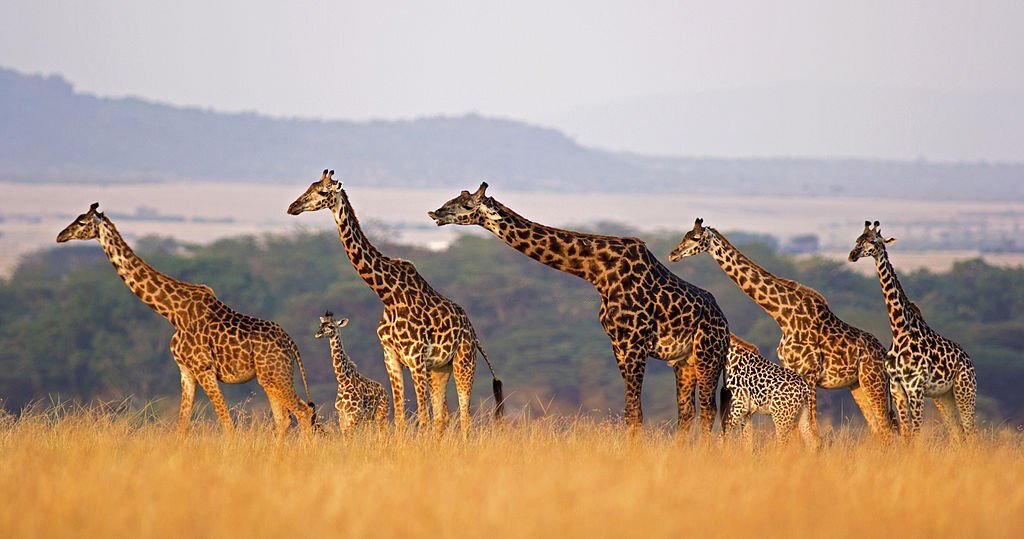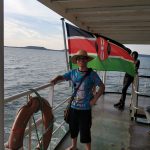
Kenya—the name is practically a euphemism for the word “safari.” There aren’t many places on Earth that inspire such a sense of exploration and romanticism. Viewing the plentiful wildlife in Kenya is at the top of the list of the diverse things to do there, which astounds everyone who visits.
In the Maasai Mara, witness swarms of wildebeest roar through the plains during the Great Migration; up close and personal with elephants in Amboseli; or take in Lake Nakuru’s thousands of flamingos. Ancient tribes like the Maasai, Kikuyu, and Samburu continue to practice their traditional ways in these sun-drenched regions, coexisting mostly in harmony with the environment.
A rich wealth of coastal gems can be found beyond the renowned safari parks. You may visit tropical islands steeped in Swahili history, snorkel and dive fish-rich coral reefs, unwind on pristine beaches, and experience the melting pot of cultures and cuisines in Mombasa and Malindi.
Kenya’s topography is magnificent. The Great Rift Valley splits the country in two and is surrounded by mountain ranges and calderas. You can climb Mount Kenya’s snow-covered equatorial summits to the east of this expansive valley and fish for trout in crystal-clear streams. Obsidian caves are found in Hell’s Gate National Park, which also hisses with natural geysers and hot springs.
Visit Nairobi if you want to experience the romanticism of Kenya’s vibrant colonial history as it was shown in the movie Out of Africa. One of the most evocative and thrilling tourist places in the world is accessible through this busy capital. With our list of the best tourist attractions in Kenya, you may learn about further locations to visit in this interesting nation.
1. Maasai Mara National Reserve
One of Africa’s most stunning game reserves is the Maasai Mara National Reserve (commonly known as “Masai Mara”). The Serengeti’s northern extension, the Mara, borders Tanzania and creates a wildlife corridor between the two nations.
It is named for the statuesque Maasai tribe, who have lived in the area for millennia and still graze their animals here while wearing red cloaks. Mara, which in their language means “mottled,” may be a reference to the way the acacia trees and cloud-covered skies cast light and shadow on the broad plains.
The park is well-known for the Great Migration, which occurs from July to October and involves tens of thousands of wildebeest, zebra, and Thomson’s gazelles moving toward and away from the Serengeti.
Numerous hippos and crocodiles lurk in the Mara River. Due to its relatively significant populations of lion, cheetah, and leopard, the park is also renowned for offering exceptional predator sightings, particularly during the dry months of December through February.
Because of the park’s elevation, the climate is pleasant and moderate all year long.
2. Amboseli National Reserve
One of Kenya’s most well-liked tourist destinations is Amboseli National Reserve, which is crowned by Mount Kilimanjaro, Africa’s highest mountain. The Maasai word “Amboseli” means “salty dust,” which is a fitting description of the dry conditions in the park.
One of the best spots in Africa to see big herds of elephants up close is the reserve. Big cats like lions and cheetahs, as well as giraffes, impalas, elands, waterbucks, gazelles, and more than 600 different species of birds, are other animals that are frequently seen in the park.
Here, nature enthusiasts can explore five distinct habitats, including the dried-up Lake Amboseli bed, wetlands with sulfur springs, savannah, and forests. Look for the Maasai locals that reside in the park’s vicinity.
3. Tsavo National Park
Tsavo, the biggest park in Kenya, is divided into Tsavo West and Tsavo East. Together, these parks cover 4% of the nation’s total land area and are home to a remarkable variety of species, as well as rivers, waterfalls, savannah, volcanic hills, and a sizable lava-rock plateau.
Tsavo East, located halfway between Nairobi and Mombasa, is renowned for photogenic vistas of enormous elephant herds rolling and soaking in red dust. A lush contrast to the dry plains and providing superb wildlife watching is the palm-fringed Galana River, which winds through the park.
The Yatta Plateau, the longest lava flow in the world, Mudanda Rock, and the Lugard Falls, which pour into rapids and crocodile-filled pools, are some of the area’s other highlights.
The northernmost parts of the park feature some of the most breathtaking landscapes, and Tsavo West is wetter and topographically more diversified. Highlights include Chaimu Crater, a fantastic place to watch raptors, Ngulia Rhino Sanctuary, and Mzima Springs, a collection of natural springs with sizable populations of hippos and crocodiles.
The deeper forest makes it harder to spot wildlife in Tsavo West, but the stunning scenery more than makes up for it.
4. Samburu, Buffalo Springs, and Shaba National Reserves
The Samburu, Buffalo Springs, and Shaba Reserves are located in an arid region in the far north of Kenya, along the banks of the palm-lined Ewaso Nyiro River.
Elsa the lioness, who became well-known through the movie Born Free, was raised by George and Joy Adamson in one of two locations, the Shaba National Reserve.
The river’s waters are essential for the survival of the wildlife in all three reserves, and many species have evolved specifically to thrive in the dry climate. These animals include Somali ostriches, Grevy’s zebras, and gerenuks, a long-necked antelope that stands on its hind legs to reach new sprouts on higher tree limbs.
The Sarara Singing Wells, neighborhood watering holes where Samburu warriors sing traditional songs while bringing water for their animals to drink, are a prominent attraction in Samburu National Reserve. Additionally, you can be rewarded with glimpses of wild dogs and big cats.
5. Lake Nakuru National Park
Large flocks of pink flamingos can be seen in Lake Nakuru National Park in Central Kenya. One of the soda lakes in the Rift Valley, Lake Nakuru, which makes up roughly a third of the park’s area, is overrun with birds.
More than 450 bird species have been identified in the park since its creation in 1961, in addition to a wide variety of other animals. Some of the creatures you might encounter include lions, leopards, warthogs, waterbucks, pythons, and white rhinos. The environments range from expansive grasslands flanking the lake to steep cliffs and woods.
The largest Euphorbia candelabrum forest in Africa is also protected by the park. These indigenous, towering, branching succulents add a striking textural addition to the landscape.
6. Lamu Island
North of Mombasa, on the little island of Lamu, is pure old-world charm. Lamu Old Town, a UNESCO World Heritage Site, was first occupied in the 12th century and is the oldest continuously inhabited settlement in Kenya.
One of the best things to do here is to stroll the maze-like streets. The buildings represent the island’s long history of trading. There are obvious Arab, European, and Indian architectural influences, but there is also a clear Swahili method. There are often intricately carved wooden doors, coral stone structures, secret courtyards, verandas, and rooftop terraces.
Visiting these places is like traveling back in time. There aren’t many, if any, motorized vehicles here, and donkeys still dominate the streets as they have for decades. Dhows plow the harbor. The majority of people in Lamu are Muslims, and both men and women dress conventionally.
The Lamu Museum, Lamu Fort, and the Donkey Sanctuary are among of the island’s top attractions. They feature exhibits on Swahili culture and the area’s maritime history.
You may relax on one of the island’s white sand beaches or enjoy an Arabic coffee in a nearby café if all the history gets a little overwhelming.
7. Lake Naivasha
Lake Naivasha, which is a refuge for birds, is located at the highest point of the Great Rift Valley. Here, more than 400 different bird species have been recorded, including African fish eagles, jacanas, white-fronted bee-eaters, and various kingfisher species.
Boating is among the best methods to see animals. Hippos splash about in the lake as giraffes, zebras, buffaloes, and elands graze nearby. Also keep an eye out for colobus monkeys in the trees.
The Crater Lake Game Sanctuary is a nature walk that is abundant in wildlife close to Lake Naivasha.
With two extinct volcanoes and the red cliffs of Hell’s Gate Gorge, the reasonably priced Hell’s Gate National Park, located just south of Lake Naivasha, offers good climbing opportunities and protects a diversity of animals.
You can stop by the Elsamere Conservation Center, the former residence of the late Joy Adamson, author of Born Free, and her husband George, for a cup of tea on the southern coast of Lake Naivasha.
Keep in mind that Lake Naivasha has been known to significantly shrink during periods of extreme drought, and the region’s thriving floriculture business is also having an impact on water quality and quantity. However, the lake is usually verdant and teeming with life.
8. Nairobi
The capital and largest city of Kenya offers a wide variety of options for tourists looking for activities besides safaris. Nairobi is renowned for having a vibrant colonial past. It originally served as the capital of British East Africa, drawing people looking to make a quick buck in the coffee and tea trades. The city’s renowned historic buildings and top-notch wildlife-related activities are open to visitors today.
Want to see some cultural sites in Kenya? In Nairobi, there are many places worth visiting. A fantastic place to see exhibits about Kenya’s history, nature, culture, and modern art is the Nairobi National Museum. The botanical gardens on the property will also appeal to gardeners.
The capital and largest city of Kenya offers a wide variety of options for tourists looking for activities besides safaris. Nairobi is renowned for having a vibrant colonial past. It originally served as the capital of British East Africa, drawing people looking to make a quick buck in the coffee and tea trades. The city’s renowned historic buildings and top-notch wildlife-related activities are open to visitors today.
Want to see some cultural sites in Kenya? In Nairobi, there are many places worth visiting. A fantastic place to see exhibits about Kenya’s history, nature, culture, and modern art is the Nairobi National Museum. The botanical gardens on the property will also appeal to gardeners.
The Karen Blixen Museum, the restored home of the well-known Danish author of the book Out of Africa, also known by her pen name, Isak Dinesen, is another well-liked tourist destination.
Visit Nairobi National Park, now a black rhino sanctuary and home to a variety of other African animals, to see wildlife without leaving the city center.
9. Nairobi National Park
Who says a safari has to go far away from Nairobi? At Nairobi National Park, just a 15-minute drive from the hubbub of Kenya’s capital, you can observe a sleeping pride of lions or a gorgeous giraffe striding across the golden grass.
One of the best things to do in Nairobi is to visit this wildlife-rich park; it makes for a worthwhile day excursion, especially if you can’t get to one of the larger game reserves.
Buffalo, leopard, zebras, wildebeest, hippos, elephants, and cheetah are among the typical safari stars that can be found here. At the park’s rhino sanctuary, visitors may also view some of the most critically endangered animals on the planet.
More than 400 kinds of birds, including the stunning grey crowned crane, live in the park, and the Nairobi Safari Walk offers a great opportunity to see wildlife up close.
Additionally, no trip to the park would be complete without stopping by the main park gates’ David Sheldrick Wildlife Trust Elephant Nursery. Save time to visit the Giraffe Centre, which is close to the well-known Giraffe Manor, where you may feed the long-necked beauties by holding them in your hands.
10. David Sheldrick Wildlife Trust Elephant Nursery
An infant elephant is hard to resist. You can interact with adorably adorable baby pachyderms and feel good about helping a vital conservation organization at the same time when you visit the David Sheldrick Wildlife Trust.
The opportunity to observe these endearing animals up close is provided by this renowned wildlife refuge, which also rescues and rehabilitates orphaned elephants. You may see the keepers bottle-feed the infant elephants here, where the young ones are raised by hand until they are two or three years old.
The elephants are moved from the sanctuary to a reintegration facility in Tsavo East National Park before being ultimately released back into the wild.
You will never forget watching these cute little pachyderms playfully roll about in the mud or poke a soccer ball around. Consider adopting an orphaned elephant, giraffe, or rhino before you travel if you want to do more to aid these majestic animals. You’ll get regular updates on its progress.
Since the nursery is conveniently located directly outside the entrance to Nairobi National Park, you may visit both of these well-known tourist destinations on the same day.
11. Malindi
Malindi, a town on the coast of Kenya north of Mombasa, has two distinct personalities. This well-known seaside town combines a modern tourist centre with a historic old town. It is also a melting pot of cultures and cuisines as a result of its long history of trade.
Travelers, many of whom are from Europe, flock to this location to dive the coral reefs of the Malindi and Watamu Marine National Parks and soak up the sun on the white sands of Watamu Beach. Bask on the stunning Malindi Beach if you’re searching for free activities to do in Kenya.
The old town, which goes back to the 12th century, also offers a taste of Swahili history. The Church of St. Francis Xavier, one of East Africa’s oldest churches, the Jami Mosque, and two pillar tombs from the fourteenth century are all located nearby.
The Vasco De Gama Cross, one of the oldest still existing structures in Africa, is located on the promontory.
The Falconry of Kenya, a facility for the treatment of sick and injured birds, is another well-liked tourist destination.
The Marafa Depression, located about 30 kilometers northeast of Malindi, is also worthwhile seeing. This collection of sandstone gorges, also known as Hell’s Kitchen or Nyari, was chiseled by the wind and rain and resembles a miniature Grand Canyon.
12. Mombasa
Mombasa attracts tourists from all over the world. It is also the biggest port and second-largest city in Kenya. Immigrants from Britain, Portugal, the Arab world, India, and Asia enrich the region’s diverse cultural mix, and their impact can be seen in both the architecture and the cuisine’s wide variety.
In reality, Mombasa is an island that is connected to the mainland by a causeway, bridges, and ferries. For 480 kilometers, coral reefs line the coastline, offering superb snorkeling and diving opportunities, particularly in Mombasa Marine National Park and the area surrounding Wasini Island. Deep-sea fishing and dolphin viewing are some well-liked activities in Mombasa.
Along the Kenyan coast, there are a ton of tourist attractions. The Old Town The Old Town, with its winding streets, historic Swahili homes, markets, and gift shops, will appeal to history aficionados.
Along with Mombasa Go-Kart, cinemas, sports venues, and an abundance of dining options, the city’s north shore is also home to other tourist attractions.
As a coastal hub, there are some excellent beaches close by for beachgoers. The white sands of Shelly, Tiwi, and Diani Beaches are popular destinations south of Mombasa, while Nyali and Bamburi Beaches are famous beaches north of the city.
13. Mount Kenya National Park
Mount Kenya National Park, a UNESCO World Heritage Site in the Central Highlands to the east of the Great Rift Valley, offers the unusual spectacle of tropical snow. It includes the 5,199-meter-high mountain bearing the same name as the nation.
Three summits covered in glaciers make up Mount Kenya, which was created by a succession of volcanic eruptions. Batian is the tallest, while Nelion, which is the second highest, is more difficult to climb. Although Lenana, the lowest summit, is thought to be the easiest to climb, difficulties can arise from unpredictably bad weather.
Carry a camera. Glaciers, lakes, and mineral springs are just a few of the breathtaking natural features, along with alpine woodland and tangles of bamboo.
Safaris offer enjoyable chances because of the richness of the flora and fauna. You might see black and white colobus monkeys, buffalo, elephants, tree hyrax, leopards, and hyenas among the local animals.
Do you intend to stay a few days? The renowned Fairmont Mount Kenya Safari Club, a luxurious resort with trout fishing, golf, and tennis, is tucked away in the foothills.
14. Hell’s Gate National Park
One of the few parks in Kenya that allows camping and allows you to explore on foot or by bicycle, Hell’s Gate National Park is a popular destination for climbers.
With two extinct volcanoes, the red cliffs of Hell’s Gate Gorge, Obsidian Caves, and Fischer’s Tower, a former volcanic plug, Hell’s Gate provides excellent climbing and trekking options.
Hot springs and natural geysers that hiss steam from cracks in the earth’s crust are examples of geothermal features. Leopards, baboons, hartebeest, elands, ostriches, gazelles, and more than 100 bird species are among the many animals that the park protects. The park also contains vulture and eagle nesting areas.
There are Maasai singing, dance, and jewelry-making displays at the Oloor Karia Maasai Cultural Centre in the park, which is very worthwhile to see.
Oddly, Hell’s Gate National Park includes Olkaria Geothermal Station. It is the first of its kind in Africa and uses heated, pressured water underground to create electricity.
15. Ol Pejeta Conservancy
Ol Pejeta Conservancy, located next to Mount Kenya National Park and around 200 kilometers north of Nairobi, is a great location for up-close wildlife encounters.
At this 90,000-acre private game reserve, where you can see the Big Five (lion, leopard, rhino, elephant, and buffalo) as well as other animals like cheetahs, hyenas, zebras, and hartebeest – all set against the stunning backdrop of snowcapped Mount Kenya – conservation and sustainability are paramount.
The conservancy’s northern and southern white rhinos are among its most famous residents, along with Baraka, a blind black rhino, who some lucky visitors may get to feed.
Self-drive or guided tours are available for seeing the animals, and admission includes a trip to the chimpanzee sanctuary. Day visitors are welcome, and if you want to prolong your wilderness trip, you can stay overnight in places like exquisite colonial ranch houses, safari cottages, and bush camps.




